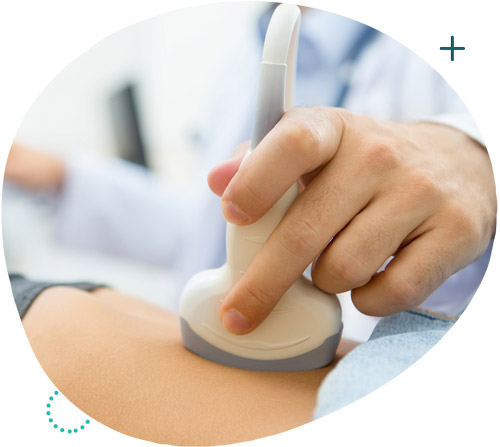This website uses cookies so that we can provide you with the best user experience possible. Cookie information is stored in your browser and performs functions such as recognising you when you return to our website and helping our team to understand which sections of the website you find most interesting and useful.
Oncology
Oncology
Ovarian and fallopian tube cancer
Globally, ovarian cancer is the seventh most common cancer in women with a higher incidence in developed countries.
A woman’s lifetime chance of developing ovarian cancer is estimated to be less than 2%, with most cases diagnosed between the ages of 50-59.
Unfortunately, the diagnosis is usually made in advanced stages, as symptoms are slow to appear. At an early stage, however, survival with appropriate treatment exceeds 90% at five years.
Stages
Stage 1, the cancer is limited to 1 or 2 ovaries or fallopian tubes and has not spread to other organs.
Stage 2, the cancer has spread to other organs in the pelvis in addition to the ovaries and fallopian tubes.
Stage 3, the cancer in addition to the ovaries and fallopian tubes has spread to other organs, outside the pelvis, and/or to the lymph nodes, and/or to the surface of the liver.
Stage 4, the cancer has spread to distant parts of the body, such as the inside of the liver, lungs.
Life expectancy
In stage 1, the prognosis is around 90% at 5 years after diagnosis.
In stage 2, at 71%.
In stage 3, at 41%.
In stage 4, at 20%.
Symptoms
These are non-specific and can go unnoticed by the woman for a long time. Feeling of abdominal fullness and satiety, flatulence (swelling), abdominal pain, frequency, loss of appetite, are some of them.
Most often, the diagnosis is made incidentally, after some examination or gynecological ultrasound and the discovery of a tumor in the abdomen.
Diagnosis and Examinations
We still do not have a reliable method of preventing ovarian cancer that is applied systematically and on a large scale, as is done for example with the Pap test and cervical cancer (Note that the Pap test is an examination that does not cover the ovaries, which means that even if the Pap test is normal, it does not rule out the existence of an ovarian malignancy).
The only tests that can give us some indications (which are applied when malignancy is suspected) are the ultrasound and the measurement of the CA-125 index in the blood.
However, studies show that these tests do not reduce mortality rates in general, but may have a benefit in detecting women with a high risk of ovarian cancer, such as heredity. Characteristically, we report that CA-125 is elevated in the blood in 50% of women with early-stage malignancy, but it can also be elevated in other benign gynecological diseases such as endometriosis.
Subsequently and on suspicion of ovarian cancer, further tests can be carried out, such as magnetic resonance imaging, computed tomography and pet-scan.
Risk factors
- Family history
- Heredity, affects 5-10% of all ovarian cancers (Lynch syndrome 2, BRCA1 and 2 oncogenes)
- Increasing age
- Infertility
Protective factors
- Pregnancy
- Contraceptive pill
- Breastfeeding
- Tubal ligation
- Hysterectomy (uterus removal)
Heredity
As we mentioned above, heredity is a strong risk factor for the development of ovarian cancer.
In recent years, with the intense publicity, the impression has been created that with appropriate gene tests we can predict all cases of ovarian cancer. But heredity is responsible for only 5 to 10% of all ovarian cancers, while these tests are complex, time-consuming, soul-destroying and very expensive.
For this reason, medical history of the patient is what will determine the conduct of these examinations on the woman and also on the immediate environment.
The most frequent problem is found in the population with a mutation of the BRCA-1 and BRCA-2 genes, a percentage corresponding to 0.25% of the general European population.
Genetic testing is generally recommended and covered by EOPYY in:
- All women diagnosed with epithelial ovarian cancer, regardless of age and family history.
- All women diagnosed with breast cancer before the age of 45.
- All women who have been diagnosed with breast Ca at any age and have at least two (2) cases from the same side of the family
- with a thorough diagnosis of breast, ovarian, pancreatic or prostate Ca with a Cleason score greater than or equal to 7.
- In women in whose family there is a known mutation of the BRCA 1/2 genes.
- If a mutation is detected, then the other family members should also be tested, based on genetic counseling.
If it is not possible to check the affected member, then the following check can be done if you have:
- History of breast cancer under the age of 40 in a first or second degree relative
- A first or second degree relative of anyone e age, with breast and ovarian cancer
- Two or more cases of breast cancer in first- or second-degree relatives, one of which was under the age of 50 or bilateral (both breasts)
- A first- or second-degree relative with breast cancer under the age of 50 or bilateral and a first- or second-degree relative with ovarian cancer
- Three cases of breast and ovarian cancer (of which at least one ovarian) in first and second degree relatives
- Two cases of ovarian cancer in first and second degree relatives
- A case of breast cancer in a first- or second-degree male relative, if another first- or second-degree relative (male or female) has breast or ovarian cancer
- You are of Jewish (Ashkenazi) descent and a relative developed ovarian or breast cancer
More specifically, BRCA-1 mutation carriers have a cumulative risk up to age 70:
- 60% for breast cancer
- 59% for ovarian cancer
- 83% for contralateral breast cancer
For BRCA-2 mutation carriers the cumulative risk rates up to age 70 are:
- 55% for breast cancer
- 16.5% for ovarian cancer
- 62% for contralateral breast cancer
Consequently, the recommended follow-up for women who are carriers of these mutations, as far as the ovaries are concerned, is twice a year clinical examination by the gynecologist, ultrasound examination and measurement of CA-125 in the blood, starting from the age of 30 years or 5 with 10 years earlier than the age of onset of ovarian cancer in a family member. Surgical removal of the ovaries is also recommended after the age of 35-40 or after the completion of family planning.
A less common effect on the general population is Lynch syndrome, a hereditary syndrome that combines various types of cancer at a younger age, such as cancer of the colon, endometrium, ovaries, urinary system.
Treatment
The treatment of ovarian cancer is mainly surgical and it is what determines the life expectancy, the earlier and more extensive it is the better.
It consists of the total removal of the uterus, ovaries and fallopian tubes, the uterus as well as any other metastatic visible damage, even part of the intestine if necessary.
These are major operations which are usually done with the open method (mid incision).
After the surgery and depending on the results of the histology, it will be decided whether the patient will need to receive a chemotherapy regimen.
In advanced stages of the disease, a chemotherapy regimen is preferred before surgery to reduce disease and optimize surgery.
In young women of reproductive age, there is the possibility of preserving the uterus and, if the conditions and stage of the disease allow, achieving a pregnancy.
As in any oncological case, the optimal treatment is individualized and results from a team of doctors of various specialties.
Borderline tumors
A special situation is borderline malignant tumors of the ovary, which, as the word says, are on the border between benign and malignant.
These tumors can also appear at younger ages, the diagnosis is not always easy but in general they have a very good prognosis with preservation of the possibility of pregnancy.









